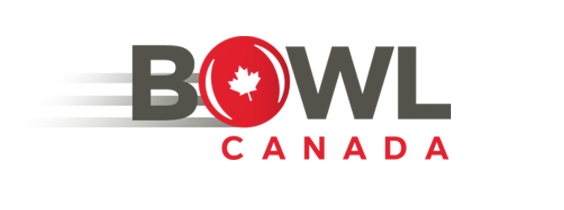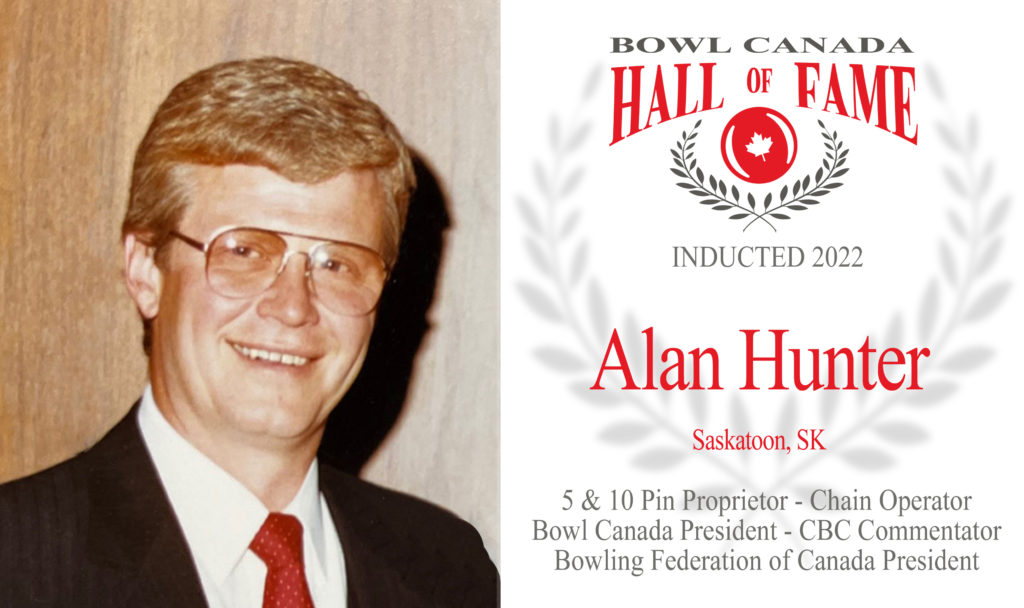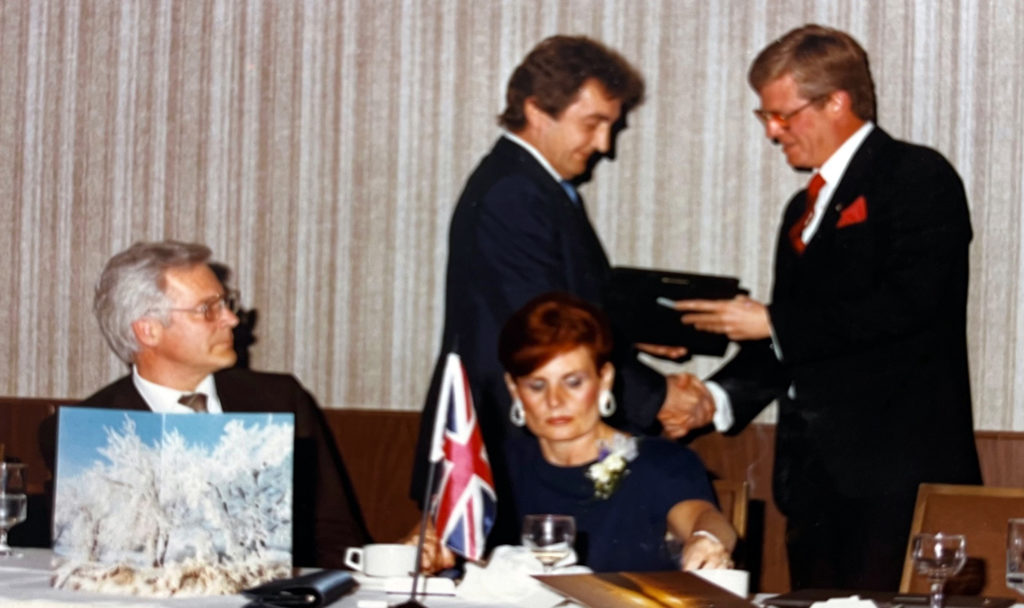RETURN TO HALL OF FAME MAIN MENU
Our 2022 inductee into the Bowl Canada Hall of Fame has played many roles through his career. Proprietor, General Manager of a chain operation, Board member, Bowl Canada President, Federation President and even TV Colour Commentator.
For many in our industry, the Hunter name is synonymous with Saskatchewan. Yet Alan was born in Calgary, Alberta. Dad Ken Hunter, known to many as “Red”, was a prominent hockey player who competed in the Canadian Air Force league during WW2. Returning from the war he settled in to play centre with the Calgary Stampeders.
Ken’s brother Bill Hunter, however, was in Saskatoon by this point and the brothers keenly wanted to get into business together. Bill arranged to have brother Ken transferred from the Stampeders to play for the Saskatoon Quakers. As soon as Ken arrived the brothers began looking into entering the bowling business. That was in 1949, and Alan was just starting his first year in school.
Settled in Saskatoon, Ken and Bill built what was then a state of the art 16 lane bowling centre…Hunter’s Bowlarena on First Avenue. It wasn’t the greatest location at the time, and getting started was a tough road to the point that Ken and Bill had to consider selling their cars to make ends meet in that first year. Keeping at it they steadily got the business healthy, and the neighbourhood improved as CN Rail vacated the area. 7 years later they proudly built their second location, KG Bowl located in the King George Hotel, adding another 24 lanes to the operation which was on its way to becoming the chain of 5 centres known today as Hunter’s Bowling Centres. Eastview Bowl and Fairhaven Bowl remain in operation today.
Alan had a front row seat to it all… learning the business from the inside out, with summer holidays spent dipping pins in lacquer, and setting pins through the school season. Pin-boys made a nickel setting 5pin and a dime for 10 pin…. and in the day that added up. Offering both games made Alan intimately knowledgeable about the many offerings of the business. He recalls, “We even had Duckpin as a novelty in the spring leagues… all the sports are good games and a lot of fun. They involve camaraderie.”
All those centre tasks became second nature to Alan, and he liked everything about the business, getting more and more involved as mechanical pinsetters came around in 1958, followed by overhead projection units. They were always looking to keep up with advancements in the industry.
Looking back, Alan remembers “YBC was on its way to 75,000 kids, had incentives, great coaching… the Master Bowlers involvement in the program was very beneficial. We had travel, billeting… bowling stood out… we were well organized and the envy of most sports. It was a great thing to watch the sport of bowling take off.”
In 1971 Alan began his run on the national board. He took on the role of YBC Chair for Saskatchewan, which at the time put him on the National Board of Directors, widening his circle and network. Looking back today he fondly remembers; “Participating in the association was a great opportunity to learn, and we believed we could make things happen. The exchange of ideas with peers was an amazing thing; Ideas on how to generate lineage, or how to run tournaments.”
From YBC Chair he moved up to take the Presidency of Bowl Saskatchewan until 1977, and in that last year began representing the national association as Golden Age Chairman. A year later, 1978 saw Alan enter into the Bowl Canada Executive Committee, and by 1989 had held all positions of the association, with his Presidency spanning from 1984 to 1986. His cohorts on the Executive read as a who’s who of the industry… He started off as Secretary to President Bob Gault (Hamilton, ON). In 1980 he was Treasurer for Frank Smith’s term (Edmonton). And 1982 saw him support President Jack Fine (Toronto) in the Vice-President’s seat. Alan’s own term as President was from 1984-86, and following that he learnt his experience and support as Past-President to Donny Walker (St. Catharines, ON).
This crack team was anchored by Carl and Inge Malcolmson at the head office. Working together, Alan and his wife Penny became very close with Carl and Inge, forming a bond that lasted through the years and together they shared many incredible successes. “We were pursuing sponsors rather successfully” he now recalls with a chuckle…. “Players, Thomas Adams, Labatt’s, Export “A”, Kellogg’s…. They were great projects. The National Classified Bowling Championships was a great exciting event that everyone loved. It was a lot of fun to set up these programs… and they generated all kinds of lineage.” Alan, whose middle name should be modesty, maintains that “Carl and Inge deserve most of the credit.”
He goes on to say that “Today, marketing is so much more complex, it’s hard to compete for attention. But for us at the time (1970’s and 80’s) we got the attention due to bowling’s popularity, and sponsors messages got heard by our audience. Sponsors were able to put some money into our well organized sport of bowling and get a profile from it. Bowling was a great vehicle for them, and we had great successes together.”
One such success came around at the time of his Presidency. In 1984 the association, then known as Bowling Proprietors Association of Canada (or BPAC) took advantage of their considerable position in society and worked with CBC Sports to develop a legacy property for the industry which became the CBC Championship Bowling Series. In planning discussions Alan was adamant that the shows be done right. “I was part of the discussion of wanting to get on television. As a sport enthusiast (spectator only) I thought I knew what we needed to do to get the sport on television and make it exciting.” In the discussions, Alan made the point that the commentators would have to understand the backgrounds of the bowlers… be able to talk about them and the sport intimately, as they would on any other sports broadcast. “I suppose they heard my passion for the project,” Alan admits, “but I was surprised that they would suggest I be involved in the shows on behalf of the sport and association. I did my best, but don’t feel I was particularly good at it. I was too self-conscious. I wanted so badly to sell our game and make it look great and have people recognize how good our sport really is.” Asked for memories of the production, Alan looks back…”It was a very good time to be involved. CBC’s Ernie Afaganis was a prince to work with. He loved bowling and got along with our athletes really well… as did all of the CBC people! They really got behind us.”
Alan represented Fivepin bowling to Canada on its network from 1984 to 1990. We can’t thank Alan enough for his work on that series and for projecting the sport positively and professionally into family rooms across the country.
When not under the studio lights, Alan was building bridges with associations as President of the Bowling Federation of Canada (from 1977-1982). As BFC President he had C5, CTF and the Masters all working together. He recalls, “We got along well at the time with other industry organizations…. Not so much today, where organizations with no youth program get funding for youth events.”
While on BFC, Alan led a BFC initiative to bridge fivepin’s East and West divide. There were 2 fivepin associations at the time, one from B.C. and one from Ontario. Bowl BC President Dave McNut led discussions, and when BFC called the vote the groups amalgamated. Looking back Alan remembers… “BFC was where all the associations spoke, listened and got things rolling. The Federation made everyone sit down and figure things out… and we did! The notion of the Federation was always a good one.”
Between national projects, Alan found the time to be instrumental in getting the bowling industry in Saskatchewan its liquor licensing. He jokes that all things balance out…. ”Up until then, league bowlers would keep a flask or two in their lockers…. Making a couple of trips a night! When licensing came in we lost a lot of our shoe locker revenue!”
Alan also put together the Molson Canadian Open (later the Labatts Open), which ran at KG Bowl for 35 years as a premiere Fivepin Championship. “It was a flashy event” he recalls, “We had bleachers, charged admission, and had over $100,000 in Prize money. We were drawing from all across Canada. All the top competitive bowlers would roll in and make a stop, and it was just a terrific event!”
Through Alan, the Hunter’s Chain of Bowling centres played a big role in helping launch Paule’s Proscore system, providing much needed seed money for development through an early purchase for 80 lanes. “We made an offer of half a million to put these scorers into our centres. Paule was then able to develop a really good product from our perspective… it was a very good time for us.” But there was a big learning curve… He goes on to explain, “We had huge problem at Fairhaven with static electricity … had we known that’s what it was it would have been simple to solve. When it got cold, friction caused more static…. and the connection to the system would shut it down. We brought in professionals from U of Saskatchewan, who brought in humidifiers and the number of breaks reduced considerably. Then eventually we got humidifiers for the whole building. But it was a painful first year.”
Now retired as General Manager of the Chain, Alan has passed his responsibilities on to his long-time friend, brother-in-law and business partner of 45 years, Ed Whitehead (also a former Bowl Canada President). They’re very pleased to see the next generation of the family all intimately involved in the business as well; daughters Megan Sawatsky and Allison Hunter, as well as nephew David Whitehead. And now grandson Joshua Sawatsky marks the fourth generation of participation in the business.
Retired or not Alan does, however, keep involved in discussions of major projects… “but otherwise I’d just be in the way.” He says with his typical modesty, going on to explain “It’s quite a different business. We are Entertainment Centres now…we still operate the sport, but the business has to be about entertainment. We slip into the league business at times, but today it’s about entertaining the customer. And the cast at Hunters Chain of centres is now focused on that.”
Alan continues to give of his time, volunteering on the Board, and as a previous President, of Cosmo Industries over the last 30 years. Cosmo Industries is an organization which creates opportunities, provides support, and challenges participants with intellectual disabilities to reach their full potential. He’s also been President of his Golf Club, lending his organizational expertise to his passions.
When asked What was the biggest challenge he and his Executive team faced he cites changes in society… “When I was a kid playing hockey, there were only 2 adults in the rink (the coaches). Parents were out golfing, or bowling or curling… they don’t do that anymore… not at the same level anyway. Prime time was 9pm because people worked till 6pm and couldn’t get home, have dinner and get to the centre until later. Today 9pm leagues are a pretty rare thing … that’s such a lifestyle change.”
When asked What stands out in his memories as a member proprietor it’s the Ideas Exchange sessions at meetings, explaining “We always knew we could pay for our trip by picking up the odd tip at these sessions. We never felt attendance was as high as it should be and that members should attend… particularly when the event is hosted in their own province.”
When asked for a favourite memory, he says it comes down to the people, explaining… “The friendships along the way were by far the most important part of the journey…with proprietors and managers across the country…. Don Walker, and Ed Champagne…So many friends from across Canada…all really good people.. hard working, and there was just a lot of satisfaction being part of that group.” Ladies and gentlemen…. We are honoured today to induct a true gentleman who has contributed to this industry’s success in a lasting and meaningful way. Another giant of our industry now enters the Bowl Canada Hall of Fame.


































